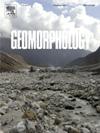解读从悬崖到分水岭的地表过程:利用宇宙成因核素和地球化学数据解读喀斯特景观
IF 3.1
2区 地球科学
Q2 GEOGRAPHY, PHYSICAL
引用次数: 0
摘要
热带喀斯特景观的特征是地貌过程和泥沙运移相互作用导致的复杂泥沙动力学。在Vermelho流域(巴西稀树草原),我们使用配对的宇宙形成核素(10Be和26Al)来量化剥蚀速率、埋藏持续时间和沉积物混合。AlBe比值的空间分布表明,悬崖上的侵蚀速度快,掩埋时间长,而平坦地区的条件更稳定,侵蚀较弱,沉积物停留时间更长。与Iraquara和Serra das Mesas的比较强调了地形和沉积物来源对核素清单的影响。下游新侵蚀物质的增加表明河流混合,而宇宙成因埋藏与OSL年龄(Tarimba洞)之间的差异表明部分埋藏和沉积前历史。宇宙成因、地球化学和地貌数据的综合凸显了热带喀斯特系统的复杂性,其中垂直混合和不均匀侵蚀是关键过程。这些结果有助于拓宽对景观演化的认识,并为解释世界范围内河流-喀斯特环境中的宇宙成因信号提供了比较依据。本文章由计算机程序翻译,如有差异,请以英文原文为准。
Decoding surface processes from escarpment to watershed: Insights from karst landscapes using cosmogenic nuclides and geochemical data
Tropical karst landscapes are marked by complex sediment dynamics resulting from the interplay between geomorphic processes and sediment transport. In the Vermelho Watershed (Brazilian savanna), we use paired cosmogenic nuclides (10Be and 26Al) to quantify denudation rates, burial durations, and sediment mixing. The spatial distribution of Al![]() Be ratios reveals rapid erosion and prolonged burial on escarpments, in contrast to the more stable conditions of flatter areas, where erosion is subdued, and sediment residence time is longer.
Be ratios reveals rapid erosion and prolonged burial on escarpments, in contrast to the more stable conditions of flatter areas, where erosion is subdued, and sediment residence time is longer.
Comparisons with Iraquara and Serra das Mesas emphasize the influence of topography and sediment sources on nuclide inventories. Downstream increases in freshly eroded material point to fluvial mixing, while discrepancies between cosmogenic burial and OSL ages (Tarimba Cave) suggest partial burial and pre-depositional histories.
The integration of cosmogenic, geochemical, and geomorphic data underscores the complexity of tropical karst systems, where vertical mixing and uneven erosion are key processes. These results contribute to a broader understanding of landscape evolution and offer a comparative basis for interpreting cosmogenic signals in fluvio-karst environments worldwide.
求助全文
通过发布文献求助,成功后即可免费获取论文全文。
去求助
来源期刊

Geomorphology
地学-地球科学综合
CiteScore
8.00
自引率
10.30%
发文量
309
审稿时长
3.4 months
期刊介绍:
Our journal''s scope includes geomorphic themes of: tectonics and regional structure; glacial processes and landforms; fluvial sequences, Quaternary environmental change and dating; fluvial processes and landforms; mass movement, slopes and periglacial processes; hillslopes and soil erosion; weathering, karst and soils; aeolian processes and landforms, coastal dunes and arid environments; coastal and marine processes, estuaries and lakes; modelling, theoretical and quantitative geomorphology; DEM, GIS and remote sensing methods and applications; hazards, applied and planetary geomorphology; and volcanics.
 求助内容:
求助内容: 应助结果提醒方式:
应助结果提醒方式:


